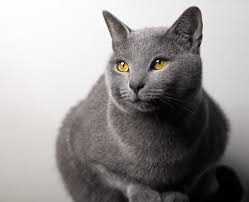
Chartreux
Conditions of detention
Chartreux cats are adaptable and can thrive in various living environments, including apartments and houses. They enjoy a calm and peaceful atmosphere and benefit from having cozy spots to relax and nap.
Useful Fact:
Chartreux cats are known for their quiet and observant nature. They are not as vocal as some other breeds, making them ideal for those who prefer a quieter pet.
Nutrition and diet
The Chartreux requires a balanced diet rich in high-quality proteins, healthy fats, and essential nutrients. Feeding schedules and portion control are important to prevent obesity, which can lead to health issues such as diabetes and joint problems.
Useful Fact: Incorporating omega-3 and omega-6 fatty acids into their diet can help maintain the health and sheen of their blue-gray coat.
Health
Generally a healthy breed, the Chartreux can be prone to certain genetic conditions such as patellar luxation and polycystic kidney disease. Regular veterinary check-ups, vaccinations, and a proactive approach to dental care are crucial for maintaining their overall health.
Useful Fact: Chartreux cats have a lifespan of around 12-15 years, with proper care contributing to their longevity.
Grooming and care
Despite their dense double coat, Chartreux cats require minimal grooming. Weekly brushing is usually sufficient to remove loose hairs and reduce shedding. Regular nail trimming, ear cleaning, and dental hygiene are also important parts of their care routine.
Useful Fact: The water-repellent nature of their coat means they rarely need baths, making grooming easier for owners.
Education and training
The Chartreux is an intelligent breed and responds well to training with positive reinforcement. They can learn basic commands, use a scratching post, and even enjoy interactive puzzle toys that stimulate their minds.
Useful Fact: Chartreux cats often enjoy clicker training, which can be a fun and effective way to teach them new tricks and behaviors.
Toys and entertainment
Chartreux cats are playful and enjoy a variety of toys, including interactive wands, feather toys, and puzzle feeders. Providing mental and physical stimulation through play is essential for their well-being.
Useful Fact: Regularly rotating toys can keep a Chartreux engaged and prevent boredom, which can lead to destructive behavior.
Safety
Keeping Chartreux cats indoors or in a secure outdoor enclosure protects them from dangers such as traffic, predators, and diseases. Ensuring the home is cat-proofed, removing hazards like toxic plants and securing small objects, is also crucial.
Useful Fact: Microchipping your Chartreux can increase the chances of being reunited if they ever get lost.
Accessories
Investing in quality accessories such as comfortable beds, sturdy scratching posts, and cat trees can enhance the living environment of a Chartreux. These items cater to their natural climbing and scratching instincts.
Useful Fact: Providing a variety of scratching posts with different textures helps satisfy their natural urge to scratch and protects your furniture.
Socialization
Chartreux cats are social and enjoy human companionship. Early socialization with different people, pets, and environments helps them develop into well-adjusted adults. They typically get along well with other cats and cat-friendly dogs.
Useful Fact: Regular interactive playtime and social interaction can prevent behavioral issues related to loneliness or boredom.
Travel and Transportation
When traveling, ensure your Chartreux is comfortable and secure in a well-ventilated carrier. Familiarize them with the carrier beforehand to reduce stress during trips. Frequent breaks and access to water are important during long journeys.
Useful Fact: Using a pheromone spray in the carrier can help calm your cat and reduce travel anxiety.
Behavior and psychology
Chartreux cats are known for their affectionate, gentle, and quiet nature. They form strong bonds with their owners and can become lonely if left alone for long periods. Providing a stimulating environment and regular interaction is key to their happiness.
Useful Fact: These cats are often described as “smiling” due to their unique facial structure, which gives them a sweet and pleasant expression.
Legal aspects
Owning a Chartreux may involve understanding and complying with local regulations, such as pet licensing, vaccination requirements, and indoor pet policies. Ensure you are aware of and adhere to these laws to avoid legal issues.
Useful Fact: Some areas may have regulations on the number of pets you can own, so check local laws if you plan to have multiple cats.


